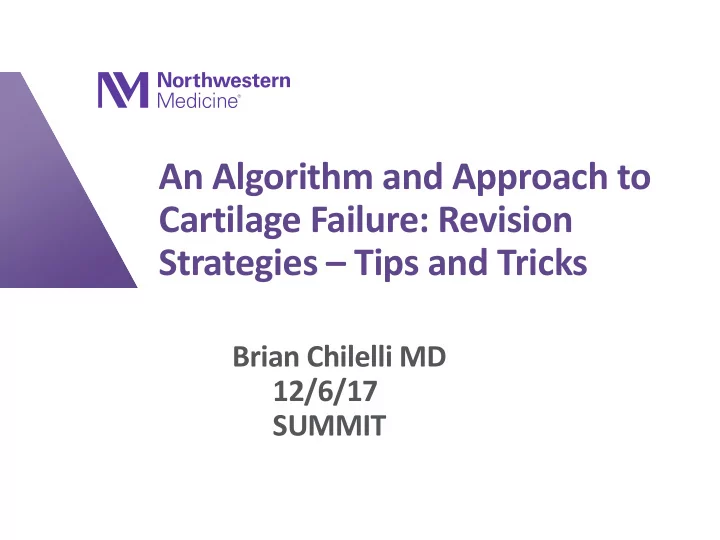

An Algorithm and Approach to Cartilage Failure: Revision Strategies – Tips and Tricks Brian Chilelli MD 12/6/17 SUMMIT
Disclosures • Consultant - Vericel
Risk Factors for Failure • Patient factors − Age − Smoking − Obesity − Inflammatory joint disease
Risk Factors for Failure • Concomitant injuries/abnormalities − Malalgnment/Maltracking − Ligamentous instability − Meniscal deficiency
Risk Factors for Failure • Defect Factors − Prior surgery − Subchondral bone − Size − Location − Number of defects − Age of defect
Mechanisms of Failure (Early failure) • Patient factors − Non-compliant (WB, CPM usage, etc) − Traumatic injury • Technical failure − Improper technique • Inadequate preparation of defect • Implantation of MACI membrane • Incongruent graft (OAT, OCA) • Lack of press fit (OAT, OCA) •
Mechanisms of Failure (Late failure) • Progression of disease • Mechanical failure − Delamination of graft • Biologic failure − Inadequate fill / repair tissue − Incomplete integration − Subchondral cysts − Intralesional osteophyte − Lack of osseous incorporation − Membrane hypertrophy
Approach to the failed cartilage patient • 4 questions to ask yourself……
Approach to Failed Cartilage Patient • Is there malalignment or maltracking present? − Obtain limb length x-rays to evaluate mechanical alignment − Scrutinize CT/MRI for TT-TG distance/TT-PCL distance
Approach to Failed Cartilage Patient • What is the status of the subchondral bone? − Is there subchondral bone deficiency present? • Consider bone restoring procedure (OAT, OCA, grafting) if > 6-10 mm of bone loss − Subchondral cysts? − Subchondral bone marrow edema?
Approach to Failed Cartilage Patient • Is there evidence of meniscal deficiency? − Patient has history of prior meniscectomy − Evaluate MRI, previous operative reports, arthroscopy pictures
Approach to Failed Cartilage Patient • Does the patient have ligamentous instability? − ACL/PCL/MCL/PLC − History of subjective patient complaints − Evaluate MRI − Office examination − Evaluate previous operative reports − Dynamic stress x-rays
Correct Malalignment/Maltracking • Osteotomy for malalignment − High tibial osteotomy (HTO) for varus alignment and medial femoral condyle defect − Distal femoral osteotomy (DFO) for valgus alignment and lateral femoral condyle defect − Tibial tubercle osteotomy (TTO) for elevated TT-TG (> 16-20mm) and lateral patellar facet defect
Address Meniscal deficiency • Medial meniscal allograft transplantation • Lateral meniscal allograft transplantation
Treatment options
Marrow stimulation (Microfracture) Failed ACI (MACI) in setting of normal subchondral bone and small lesion (<2cm 2 )
Particulated juvenile articular cartilage allograft (PJAC) • Failed marrow stimulation (microfracture) or ACI (MACI) in the setting of normal subchondral bone
Osteochondral Autograft Transfer (OAT) • Failed marrow stimulation (microfracture) or ACI (MACI) • Ideally in small lesions (<2cm 2 )
Autologous Chondrocyte Implantation (MACI) • Failed marrow stimulation (microfracture) in setting of normal subchondral bone
Osteochondral Allograft Transplantation (OCA) • Failed marrow stimulation (microfracture), ACI (MACI), OAT, or previous OCA • Effective in normal or abnormal subchondral bone
ACI (MACI) with subchondral bone grafting (Sandwich technique) • Femoral condyle or patellofemoral defect with abnormal subchondral bone and osteochondral allograft is not available
What about ACI (MACI) or OCA after marrow stimulation (microfracture) ……???
ACI following microfracture/marrow stimulation • Peska et al. AJSM 2012 • Compared 28 patients treated with ACI after microfracture had failed to 28 patients treated with ACI as a first line treatment • Mean follow up of 48 months • Significantly more failures associated with ACI after microfracture (7 of 28) than with ACI as a first line treatment (1 of 28) • Inferior clinical outcome was also associated with ACI after microfracture. •
ACI following microfracture/marrow stimulation • Minas et al. CORR 2014 • Subgroup analysis of their long-term outcome study • Graft survival at 15 years was 79% in patients without microfracture prior to ACI and only 44% in patients who underwent microfracture prior to ACI
Osteochondral allograft transplantation following microfracture/marrow stimulation • Gracitelli et al. AJSM 2015 • 46 patients- OCA following failed marrow stimulation − 20 of 46 knees (44%) reoperation − 7 of 46 knees (15%) failed − 10 year survivorship – 86% • 46 patients- primary OCA − 11 of 46 knees (24%) reoperation − 5 of 46 knees (11%) failed − 10 year survivorship – 87.4% • No difference in functional outcomes or survivorship
My preference… • Failed marrow stimulation (microfracture) − Patellofemoral – ACI (MACI) or PJAC − Femoral condyle – OAT (small lesion, <2cm 2 ), OCA (large lesion, >2cm 2 ) • Failed ACI (MACI) − Patellofemoral – PJAC (normal subchondral bone) or OCA − Femoral condyle – PJAC (normal subchondral bone) or OAT (small lesion, <2cm 2 ), OCA (large lesion, >2cm 2 ) • Failed OAT / OCA − Patellofemoral – Revision OCA − Femoral condyle – Revision OCA
Final Pearls • Ask yourself the 4 questions − 1. Malalignment? − 2. Subchondral bone? − 3. Meniscal deficiency? − 4. Ligamentous insufficiency? • Have a low threshold to consider diagnostic arthroscopy prior to making definitive plan • Each patient is different!...patient factors play a large role in the decision process
Recommend
More recommend